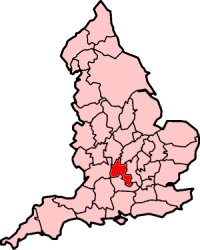

The county of Oxfordshire in England was formed in the early years of the 10th century and is broadly situated in the land between the River Thames to the south, the Cotswolds to the west, the Chilterns to the east and The Midlands to the north, with spurs running south to Henley-on-Thames and north to Banbury.[citation needed]
Historically the area has always had some importance, containing valuable agricultural land in the centre of the country and the prestigious university in the county town of Oxford (whose name came from Anglo-Saxon Oxenaford = "ford for oxen").[citation needed] Ignored by the Romans, it was not until the formation of a settlement at Oxford in the 8th century that the area grew in importance. Alfred the Great was born across the Thames in Wantage, then in Berkshire. The University of Oxford was founded in 1096, though its collegiate structure did not develop until later on. The area was part of the Cotswolds wool trade from the 13th century, generating much wealth, particularly in the western portions of the county in the Oxfordshire Cotswolds. Morris Motors was founded in Oxford in 1912, bringing heavy industry to an otherwise agricultural county. The importance of agriculture as an employer has declined rapidly in the 20th century though; currently under one percent of the county's population are involved due to high mechanisation.
There are fourteen hundreds in Oxfordshire, among them being five of the Chiltern hundreds. The jurisdiction over these five belonged to the manor of Benson, and in 1199 to Robert de Harecourt, a name which is still to be found in the county in the Harcourts of Stanton Harcourt and Nuneham. The county includes small portions formerly of Berkshire and Buckinghamshire, which lie in the hundreds of Bampton and Ploughley respectively.[1]
Throughout most of its history the county was divided into fourteen hundreds, namely Bampton, Banbury, Binfield, Bloxham, Bullingdon, Chadlington, Dorchester, Ewelme, Langtree, Lewknor, Pyrton, Ploughley, Thame and Wootton.[citation needed]
There has been little change in the county boundary; but acts of William IV and Victoria slightly increased its area.[1]
- ^ a b Chisholm 1911, p. 416.
© MMXXIII Rich X Search. We shall prevail. All rights reserved. Rich X Search
